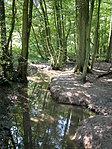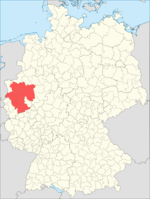Max Planck Institute for Coal Research
1912 establishments in GermanyChemical research institutesMax Planck InstitutesMülheimOrganisations based in North Rhine-Westphalia

The Max-Planck-Institut für Kohlenforschung (German: Max-Planck-Institut für Kohlenforschung) is an institute located in Mülheim an der Ruhr, Germany specializing in chemical research on catalysis. It is one of the 86 institutes in the Max Planck Society (Max-Planck-Gesellschaft). It was founded in 1912 in Mülheim an der Ruhr as the Kaiser Wilhelm Institute for Coal Research (Kaiser-Wilhelm-Institut für Kohlenforschung) to study the chemistry and uses of coal, and became an independent Max Planck Institute in 1949.
Excerpt from the Wikipedia article Max Planck Institute for Coal Research (License: CC BY-SA 3.0, Authors, Images).Max Planck Institute for Coal Research
Stiftstraße, Mülheim an der Ruhr Menden-Holthausen (Rechtsruhr-Süd)
Geographical coordinates (GPS) Address Website Nearby Places Show on map
Geographical coordinates (GPS)
| Latitude | Longitude |
|---|---|
| N 51.417777777778 ° | E 6.8863888888889 ° |
Address
Max-Planck-Institut für chemische Energiekonversion
Stiftstraße 34-36
45470 Mülheim an der Ruhr, Menden-Holthausen (Rechtsruhr-Süd)
North Rhine-Westphalia, Germany
Open on Google Maps









